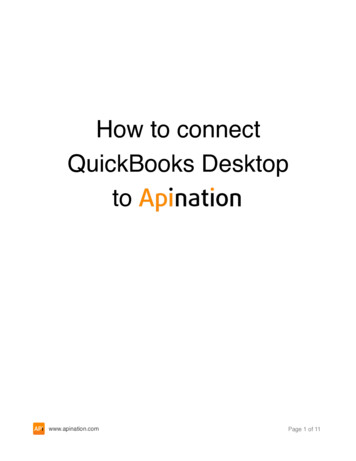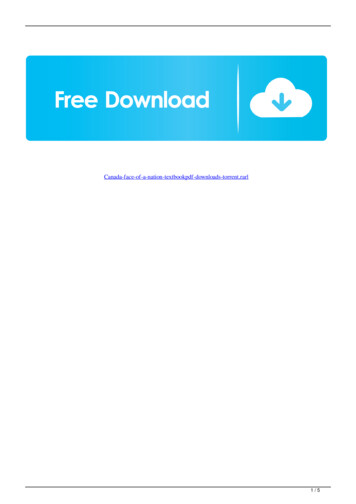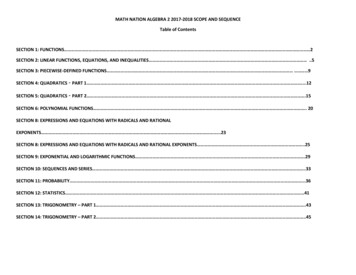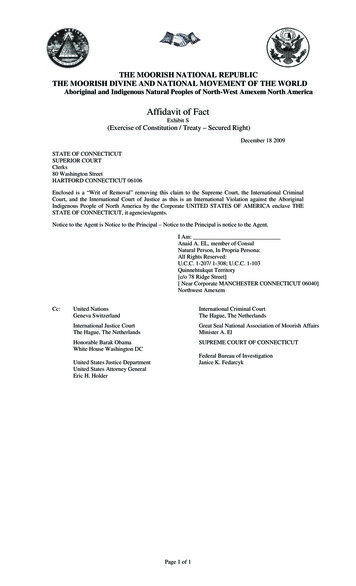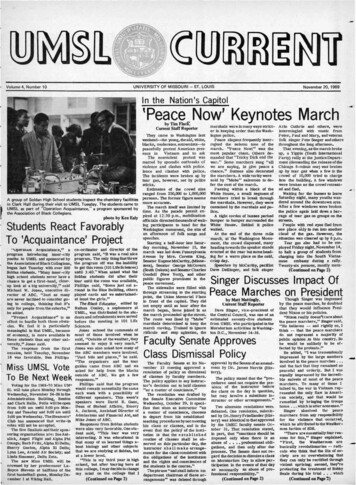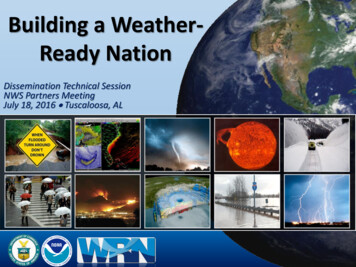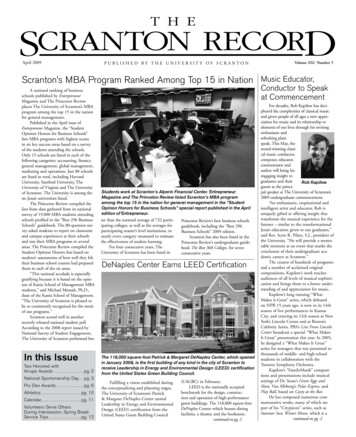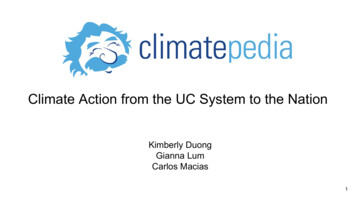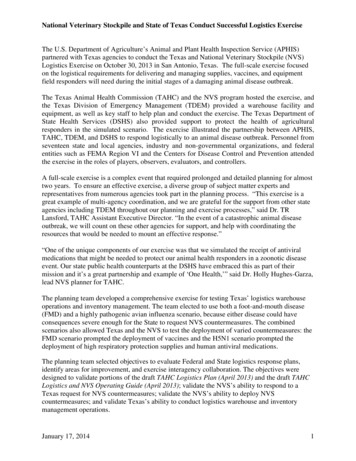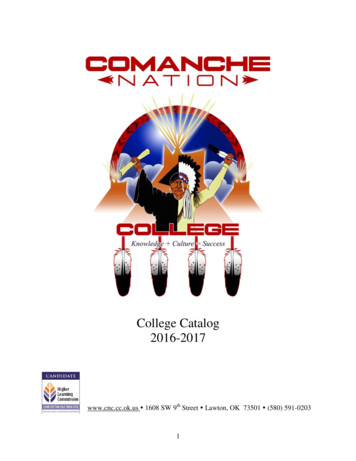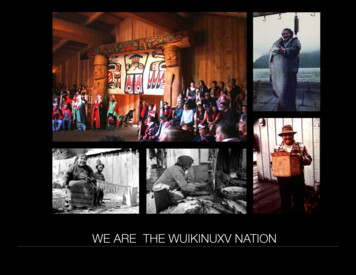
Transcription
WE ARE THE WUIKINUXV NATION
WE ARE THE WUIKINUXV NATIONA collaboration with the Wuikinuxv Nation.Written and produced by Pam Brown, MOA Curator, Pacific Northwest, 2011.1
We Are The Wuikinuxv NationUBC Museum of Anthropology Pacific Northwest sourcebook seriesCopyright Wuikinuxv NationUBC Museum of Anthropology, 2011University of British Columbia6393 N.W. Marine DriveVancouver, B.C. V6T 1Z2www.moa.ubc.caAll Rights ReservedA collaboration with the Wuikinuxv Nation, 2011.Written and produced by Pam Brown, Curator, Pacific Northwest,Designed by Vanessa KroekerFront cover photographs, clockwise from top left:The House of Nuakawa, Big House opening, 2006. Photo: George Johnson.Percy Walkus, Wuikinuxv Elder, traditional fisheries scientist and innovator. Photo: Ted Walkus.Hereditary Chief Jack Johnson. Photo: Harry Hawthorn fonds, Archives, UBC Museum of Anthropology.Wuikinuxv woman preparing salmon. Photo: C. MacKay, 1952, #2005.001.162, Archives, UBC Museum of Anthropology.Stringing eulachons. (Young boy at right has been identified as Norman Johnson.) Photo: C. MacKay, 1952, #2005.001.165,Archives, UBC Museum of Anthropology.Back cover photograph: Set of four Hàmac! a masks, collection of Peter Chamberlain and Lila Walkus.Photo: C. MacKay, 1952, #2005.001.166, Archives, UBC Museum of Anthropology.MOA programs are supported by visitors, volunteer associates, members,and donors; Canada Foundation for Innovation; Canada Council for the Arts;Department of Canadian Heritage Young Canada Works; BC Arts Council;Province of British Columbia; Aboriginal Career CommunityEmployment Services Society; The Audain Foundation for theVisual Arts; Michael O’Brian Family Foundation; VancouverFoundation; Consulat General de Vancouver;and the TD Bank Financial Group.2
AcknowledgementsThis sourcebook gives you a glimpse of the people of the Wuikinuxv Nation through historical Wuikinuxv artwork, archivalphotographs, contemporary perspectives and photographs. We gratefully acknowledge all those who have givengenerously of their time and knowledge for the sourcebook and labels for the Wuikinuxv case in the new MultiversityGalleries of the UBC Museum of Anthropology (MOA).The 15 historical objects in MOA’s Wuikinuxv collection date from as early as 1890 to as recently as 1969. The Museumhas been working with the Wuikinuxv on the Partnership of Peoples Project since 2008. Particular thanks are due to theWuikinuxv Treaty Office and Wuikinuxv Council, the Elders, and community members Evelyn Windsor, Peter Johnson,George Johnson, and Terry Ivan Reid who shared their knowledge and stories for the project.Thanks to George Johnson, Jennifer Walkus, Terri Reid, Wuikinuxv Treaty Office, MOA Archives, and Wuikinuxv Council,who provided photographs.And for their invaluable advice, research, consultation, and assistance, thanks to Peter Johnson, Council Representative;George Johnson, Researcher, Wuikinuxv Treaty Office; Nigel Haggan; Joanne Kienholz, UBC student/researcher; andDavid Stevenson.- Pam Brown, MOA Curator, Pacific Northwest, 2011.3
Who We AreYau, we are people of the Wuikinuxv Nation. We are honoured to share with you a glimpse of our rich culture and history.Before European contact, we were one of the largest nations on the Pacific Northwest Coast. Our traditional territoryextends from Koeye River to Cranston Point to the head of Wuikinuxv Lake. We have lived here for over ten thousandyears.Our lands and resources are as important to us as the air we breathe. Our ancestors have taught us that ‘this land is ourresponsibility.’ This responsibility is so instilled in us that it is a part of who we are and how we live today.Giànakci.4
Left: The Nispiq Pole belonged to Chief Simon Walkus Sr. and tells of the origin of the Wuikinuxv people.Photo: C. MacKay, 1952, #2005.001.170, Archives, UBC Museum of Anthropology.Right: House of Chief Albert Harry at Kítit Village. From left to right: Kitty Harry, Albert Harry, Ned Wesley, Thomas Hàilh!mas, and Mary Johnson-Walkus.Photo: C. MacKay, 1952, #2005.001.167, Archives, UBC Museum of Anthropology.5
Location and ServicesOur traditional territory lies 300 miles northwest of Vancouver, and is only accessible by boat and floatplane. Ourcommunity is located on the banks of the Waanukv River, which connects Owikeno Lake to the head of Rivers Inlet.We have an airstrip and daily service from a local airline. The nearest town is Port Hardy across the Queen CharlotteStrait. In order to access education, health care, and obtain employment, the majority of our people find it necessary toleave our community and ancestral homeland.Language: W’uik’ala is a Northern Wakashan language spoken by the Wuikinuxv people.Population: 300Wuikinuxv Territory.Photo: Terri Reid, 2009.6
8Wuikinuxv Traditional TerritoryWuikinuxv Nation Map courtesy of the Wuikinuxv Treaty Offfice; First Nations of British Columbia Map reproduced courtesy of UBC Museum of Anthropology.
Wuikinuxv Territory.Photos: Terri Reid, 2009.9
Responsibility to our LandsOur strong historic sense of responsibility to our lands is evident in the following statement by Chief Joseph Chamberlainto the Royal Commission on Indian Affairs, held at Rivers Inlet, Saturday, August 16th, 1913, 2:00 pm:We want to get the whole of Rivers Inlet, from Quay to the land—Oweekeno Lake. The white men wants totake all our land and we are in the position of men who have been pushed half way to the water off our land,and it would not take much to push us off the land into the deep water altogether. Sometimes I go round inthe timber and see a post; sometimes we get inside the post. And then they come and take our logs. I thinkthat all this is our land and we should not be afraid to take logs anywhere. In the old time the Lord put ourfathers here among these mountains and trees. He also put the salmon there for their food. Sometimes theyneed to skin the bark off the hemlock trees and eat it for food. Wherever these Government posts are now wecannot work, and that is not good according to our mind. We are very despairing. We have heard that theGovernment will take land and sell it, but we don’t want to sell our land here, but we would like a yearly rentalfor it. All these canneries round here should pay us a rental for the use of the land. The canneries come hereand we cannot understand how they came. If the Government sell this land to the canneries—did theGovernment sell this land to the canneries—that is what we want know? All this land is ours and we want toreserve it for our children.10
Stringing eulachons. (Young boy at right has been identified as Norman Johnson.)Photo: C. MacKay, 1952, #2005.001.165, Archives, UBC Museum of Anthropology.11
Chief Joseph Chamberlain, continued:If any of the white men want any of the land we are willing to sell or lease it to them for the benefit of ourchildren. We have a lot of little houses up and down the rivers and on the lakes, and there are timber limitsposts put all over there where we used to reside.There is a house on Moses Inlet belonging to Johnnie Carroll and I hear that white men have taken the boardsoff the house and broken the house. I don’t like to hear that the white men have broken the Indian’s house. If anIndian had done the same thing to a white man’s house he would have been put in jail. I don’t know who thewhite man is who broke Johnnie Carroll’s house open. I only hear that it was broken.The reason we want to get this land from Quay to Smith’s Inlet is to make our food supplies secure, and sothat we will be able to keep the fish for ourselves. No one has ever stopped us yet but we are afraid someonemay do so in the future and we would lose this means of our subsistence. There may be encroachments onthe land. This is what we are afraid of. Next month half of my people will be up the lake and half down here tohunt furs and fish for salmon.If I now lose all this land how are we going to get the money for the furs, which we otherwise would have if theland belonged to us? There are thirty-eight places where we get salmon and furs from. That is all we have tosay just now.12
Left: Interior of a traditional Big House at the Island of Kítit. This house is believed to belong to Maggie Nagiazi.Photo: C. MacKay, 1952, #2005.001.162, Archives, UBC Museum of Anthropology.Right: House post in the house of Thomas Hàilh!mas on Kítit Island.Photo: C. MacKay, 1952, #2005.001.172 Archives, UBC Museum of Anthropology.13
The Wuikinuxv are rich interritory, culture, and historyOur people have lived in Wuikinuxv Territory in the Central Coast region of British Columbia for over ten thousand years.Before the arrival of the Europeans, our people thrived, surrounded by an abundance of rich natural resources. On thisfoundation we built a complex and well-organized society.Right: This set of four Hàmac" a masks belonged to the late Peter Chamberlain and Lila Walkus.Photo: C. MacKay, 1952, #2005.001.166, Archives, UBC Museum of Anthropology.14
The Wuikinxuv have been widely recognized on the coast for the spread of their winter ceremonial dances. Theyconsisted of two main series of dances, the "Caiga and the Dhw" !làx# a series. The highest dance of the "Caiga series is therenowned Cannibal-Spirit or Hàmac" a dance.This Hàmac" a mask (A1745) was collected by the Reverend George Henry Raley in Bella Bella between 1893 and 1934,and incorrectly identified as Heiltsuk. Consultation with Wuikinuxv community members and other First Nations expertsrecently confirmed its Wuikinuxv origin. The style is very similar to the Hàmac" a masks from Kítit Island shown in theprevious photo.According to Wuikinuxv Elder Evelyn Windsor (personal correspondence with Terry Ivan Reid, 2009), “Masks like thiswere from the Owikeno Lake area and tended to use less colour due to their isolation.”Right: Hàmac" a mask (A1745). Collection, UBC Museum of Anthropology. Photo: Derek Tan, UBC Museum of Anthropology.16
The great forests of the area provided the Wuikinuxv with the Western Red Cedar. Our ancestors carved ocean-goingand river canoes, totem poles, and built Big Houses and boardwalks from cedar. The bark was set aside and used tomake clothing, baskets and other household items.A canoe bailer (Nb3.1455) like this was used for both river- and ocean-going red-cedar canoes that travelled the creeks,rivers, and oceans near and beyond Wuikinuxv Territory.18
Left: Canoe Bailer (Nb3.1455). Collection, UBC Museum of Anthropology. Photo: Derek Tan, UBC Museum of Anthropology.Right: Dugout cedar canoe, Rivers Inlet. Photo: Andrew Johnson, 2005.19
Historically, the Wuikinuxv survived primarily on the millions of salmon that swam upriver to spawn. To a great extent,Wuikinuxv culture revolved around fishing, which was a great source of wealth for the community.White settlers were quick to exploit the immense quantities of fish, building sixteen canneries around Rivers Inlet duringthe late 1800s. The lives of the Wuikinuxv were significantly marked by cannery life. Many Wuikinuxv Elders rememberworking in the canneries with Chinese, Japanese and European immigrants. Since that time, the salmon population hasdropped so dramatically that commercial fishing is now nearly non-existent among the Wuikinuxv.Each family was responsible for the health and well being of their area. Today we still hold this responsibility high. Werealize that we have a relationship with the resources and our land. Our Territory needs us to look after it in order to thriveas much as we need it to survive.Right: Wuikinuxv woman preparing salmon.Photo: C. MacKay, 1952, #2005.001.164, Archives, UBC Museum of Anthropology.20
Percy WalkusPercy Walkus founded the Wuikinuxv Salmon Enhancement Program. His memory continues to inspire young people tocherish and protect the fisheries.Right: Percy Walkus, Wuikinuxv Elder, traditional fisheries scientist and innovator. Photo: Ted Walkus.22
23
Hereditary Chief, Yàxzi Jack JohnsonHereditary Chief, Yàxzi Jack Johnson, was a cultural historian, artist, composer, storyteller, logger, and fisherman of theWuikinuxv Nation. He was born March 15, 1900 in Zawias, Eulachon Town, one of our old reserve sites on the WaanukvRiver. He descends from the House of the Whale’s Tale at Kítit (Smoke House Island), one of the original Wuikinuxvvillages.Right: Hereditary Chief Jack Johnson. Photo: Harry Hawthorn fonds, Archives, UBC Museum of Anthropology.24
25
ˇXvùsemdaas WaakasWuikinuxv Elder Nuuwagawa (Evelyn Windsor) shares some of the history of the Raven House-Front Pole (A50006),which once belonged to her father (personal correspondence with Terry Ivan Reid, 2009):This pole [A50006] belonged to my late father, Simon Walkus, Sr. (1900–1969), a hereditary chief. His name,ˇXvùsemdaas Waakas, means ‘First to drink at the head of the Great River.’The name of the pole is not remembered; it was only known as the Raven Pole. It stood in front of my father’shouse at Kítit, an island located at the head of the Waanukv River. The house was called Galuthudala, whichmeans “protruding above the rest.” There were at least seven other Big Houses there; his was at the centre.26
Raven House-Front Pole, Wuikinuxv (A50006). Collection, UBC Museum of Anthropology.Photo: Bill McLennan, UBC Museum of Anthropology.27
The House of Nuakawa: completed in the fall of 2006, the first Big House in many years,this is one example of the focus on rebuilding Wuikinuxv society.28
Left: House posts under construction, 2006. This page: Big House opening.Photos: George Johnson.29
Wuikinuxv - Our FutureOur ancestors have been living here for thousands of years. Our ancestors have taught us that ‘this land is ourresponsibility.’ We see the effects of over-harvesting, global warming and neglect first hand. We’ve seen thefish stocks collapse, had to shoot the bears we’ve seen grow from cubs because they are starving. We’vehad to explain to our children that shooting that bear they’ve seen since it was a cub was kinder than letting itstarve to death.“No fish” doesn’t just mean that we don’t get a fish to eat or sell; it means our land is hurting. We hurt becauseit does. We want a say in how the resources are managed in our territory to remind those who seek to benefitfrom them that they aren’t a commodity to be sold. Every resource is a part of the system. Each part that istaken out, or over-harvested, affects everything that depends on it. If we don’t take care of it today, it won’tbe there in the future. Those who are just after the commodity will move on. We’ve seen it happen with theCanneries. But those of us who will be left here because we are tied to our land by ties of blood and history willhave to work harder to survive.(Wuikinuxv Treaty Office)Opposite page: Wuikinuxv Territory.Photo: Terri Reid, 2009.30
BibliographyBoas, Franz1928 Bella Bella Texts. New York: Columbia University Press.1932 Bella Bella Tales. Memoirs of the American Folklore Society, 25. New York: Columbia University Press.Hanuse, Roy, Sr., Hilda Smith & David Stevenson, eds.1982 The Adjee and the Little Girl. Rivers Inlet, BC: Oowekyala Language Project.Hilton, Suzanne, and John C. Rath, eds.1982 Oowekeeno Oral Traditions as told by the Late Chief Simon Walkus Sr. Evelyn Windsor, trans. National Museumof Man Mercury Series, Canadian Ethnology Service Paper, 84. Ottawa: National Museum of Man.Howe, Darin M.1998 Aspects of Heiltsuk Laryngeal Phonology. Unpublished MS, Department of Linguistics, University of BritishColumbia.2000 Oowekyala Segmental Phonology. Ph.D. dissertation, Department of Linguistics, University of British Columbia.Johnson, S., Hilda Smith, and David Stevenson1983a Fishing at Rivers Inlet. Rivers Inlet, BC: Oowekyala Language Project.1983b ’Katemxvs ’Wuik’ala. Rivers Inlet, BC: Oowekyala Language Project.1983c Qaquthanugva uikala. Rivers Inlet, BC: Oowekyala Language Project.32
1983d Sisa’kvimas. Rivers Inlet, BC: Oowekyala Language Project.1983e What time is it? Rivers Inlet, BC: Oowekyala Language Project.1984 Oowekyala words. Rivers Inlet, BC: Oowekyala Language Project.Lincoln, Neville J., and John C. Rath1980 North Wakashan Comparative Root List. National Museum of Man Mercury Series, Canadian Ethnology ServicePaper, 68. Ottawa: National Museum of Man.Poser, William J.2000 The Status of Documentation for British Columbia Native Langauges. Yinka Dene Language Institute, TechnicalReport, 2. Vanderhoof, BC: Yinka Dene Language Institute.Rath, John C.1981 A Practical Heiltsuk-English Dictionary with a Grammatical Introduction, vols. 1 & 2. National Museum of ManMercury Series, Canadian Ethnology Service Paper, 75. Ottawa: National Museum of Man.Stevenson, David1980 The Oowekeeno people: A Cultural History. Ottawa, Ontario: National Museum of Man, (now Hull,Quebec: Museum of Civilization). Unpublished.33
1982 The ceremonial names of the Ooweekeeno people of Rivers Inlet. Unpublished MS, Ottawa, Ontario: NationalMuseum of Man, Ottawa (now Hull, Quebec: Museum of Civilization).Storie, Susanne, ed.1973 Oweekeeno Stories. Special Collections E99. Victoria: British Columbia Indian Advisory Committee.Wuikinuxv Treaty OfficeN.d. http://www.wuikinuxvtreaty.com, accessed September 3, 2010.34
35
WuikinuxvYau, we are the Wuikinuxv Nation.We are honoured to share with you a glimpse of our rich culture and history.
We have lived here for over ten thousand years. Our lands and resources are as important to us as the air we breathe. Our ancestors have taught us that ‘this land is our responsibility.’ This responsibility is so instilled in
